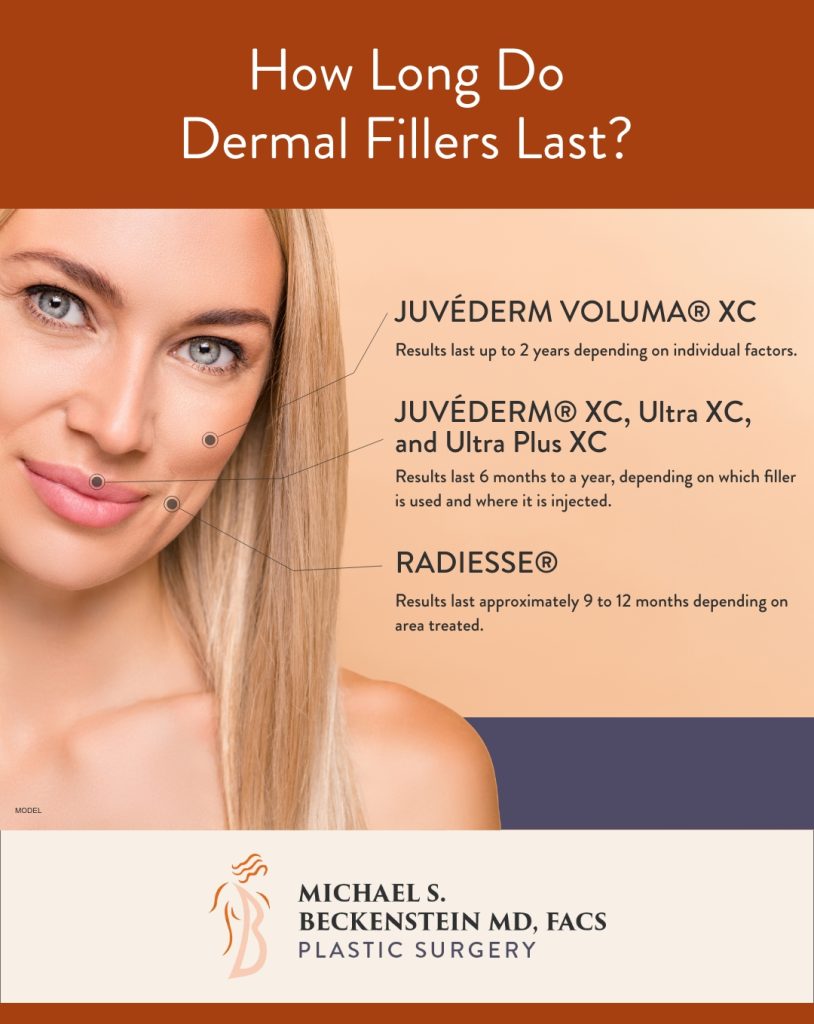Dermal fillers remain one of the most popular cosmetic treatments year after year because of their versatility and effectiveness. Beyond addressing lines and wrinkles by restoring facial volume, fillers contour cheeks, jawlines, and noses, while lip fillers produce plumper, more sensuous lips. We can also combine fillers with BOTOX® injections as part of a “liquid facelift.”
So how long does JUVÉDERM® last? How long does RADIESSE® last? The longevity of fillers is one of the primary considerations for patients, and several factors contribute to how long the results last. Not all fillers are composed of the same ingredients, and even within the same product line, different formulations have different staying power. In this post, we’ll explore the factors that affect filler longevity, and how you can get the most from your filler results.
Different Fillers, Different Longevity
The type of filler is the most important factor when considering how long they last. Most fillers, including the JUVÉDERM and Restylane product lines, are hyaluronic acid-based fillers. Hyaluronic acid is a gooey substance the body naturally produces that’s found in the joints and eyes, in addition to the skin. Its role in keeping skin looking youthful is hydration and elasticity. Besides being used in fillers, hyaluronic acid is commonly used in moisturizing creams, lotions, ointments, and serums.
HA fillers typically last from 6 months to 24 months, depending on the product. JUVÉDERM VOLUMA®, for example, is a thicker gel than other fillers and may last up to 2 years when injected deep into the cheeks.
Hyaluronic acid fillers are often called volumizing fillers. Biostimulator fillers, including RADIESSE® and Sculptra® Aesthetic, use other ingredients that gradually stimulate collagen production. These fillers tend to last longer than HA fillers but come with a caveat—unlike HA fillers, they can’t be reversed if a patient is disappointed in the results.
Other Factors That Influence How Long Fillers Last
Besides the type of filler product used, several other factors can influence dermal filler longevity. These include:
- Where the filler is used on your face
- The amount injected
- How fast your body metabolizes the filler material
Fillers begin gradually degrading during the first few months after being injected, but you’ll still see consistent results because fillers absorb water and create a fuller, more youthful appearance. Most patients start noticing a decrease in volume at about the midpoint of the expected duration of a given filler. That’s why we recommend touch-up filler treatments that can sustain the results for much longer.
Longevity of Filler Results: An Area-by-Area Breakdown

Get More Miles From Your Filler
There are a few steps you can take to help make dermal fillers last longer.
- Choose an experienced injector
- Follow a healthy skincare routine designed for your type of skin
- Practice healthy lifestyle habits that include staying hydrated and using sunscreen daily
You can also read about the best fillers for every age in our related blog post.
Explore Your Dermal Filler Options
If you would like to learn more about how dermal fillers can rejuvenate your face, please request a consultation or call us at (205) 933-9308 to get started.


Leave a Reply